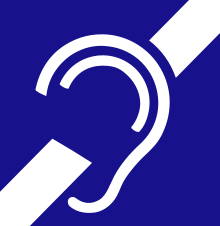
Back فقد السمع الناجم عن الضوضاء Arabic Lärmschwerhörigkeit German Perte d'audition due au bruit French 騒音性難聴 Japanese Lawaaidoofheid Dutch Uraz akustyczny Polish Perda auditiva induzida por ruído Portuguese Noise-induced hearing loss SIMPLE Humbja e dëgjimit e shkaktuar nga zhurma Albanian Bullerskador Swedish
| Noise-induced hearing loss | |
|---|---|
 | |
| The international symbol of deafness and hearing loss | |
| Specialty | Otorhinolaryngology, audiology |
Noise-induced hearing loss (NIHL) is a hearing impairment resulting from exposure to loud sound. People may have a loss of perception of a narrow range of frequencies or impaired perception of sound including sensitivity to sound or ringing in the ears.[1] When exposure to hazards such as noise occur at work and is associated with hearing loss, it is referred to as occupational hearing loss.[2]
Hearing may deteriorate gradually from chronic and repeated noise exposure (such as to loud music or background noise) or suddenly from exposure to impulse noise, which is a short high intensity noise (such as a gunshot or airhorn).[1] In both types, loud sound overstimulates delicate hearing cells, leading to the permanent injury or death of the cells. Once lost this way, hearing cannot be restored in humans.[3]
There are a variety of prevention strategies available to avoid or reduce hearing loss. Lowering the volume of sound at its source, limiting the time of exposure and physical protection can reduce the impact of excessive noise.[4] If not prevented, hearing loss can be managed through assistive devices and communication strategies.
The largest burden of NIHL has been through occupational exposures; however, noise-induced hearing loss can also be due to unsafe recreational, residential, social and military service-related noise exposures.[5] It is estimated that 15% of young people are exposed to sufficient leisure noises (i.e. concerts, sporting events, daily activities, personal listening devices, etc.) to cause NIHL.[6] There is not a limited list of noise sources that can cause hearing loss; rather, exposure to excessively high levels from any sound source over time can cause hearing loss.
- ^ a b Alberti PW (February 1992). "Noise induced hearing loss". BMJ. 304 (6826): 522. doi:10.1136/bmj.304.6826.522. PMC 1881413. PMID 1559054.
- ^ National Institute for Occupational Safety and Health, CDC (1996). Preventing Occupational Hearing Loss - A Practical Guide. Cincinnati: DHHS- 96-110. pp. iii.
- ^ Henderson D, Hamernik RP, Dosanjh DS, Mills JH (1976). Noise-induced hearing loss. New York: Raven. pp. 41–68.
- ^ "CDC - Engineering Noise Control - NIOSH Workplace Safety and Health Topic". www.cdc.gov. 5 February 2018.
- ^ Saunders GH, Griest SE (2009). "Hearing loss in veterans and the need for hearing loss prevention programs". Noise & Health. 11 (42): 14–21. doi:10.4103/1463-1741.45308. PMID 19265249.
- ^ Carter L, Williams W, Black D, Bundy A (2014). "The leisure-noise dilemma: hearing loss or hearsay? What does the literature tell us?". Ear and Hearing. 35 (5): 491–505. doi:10.1097/01.aud.0000451498.92871.20. PMID 25144250. S2CID 5606442.